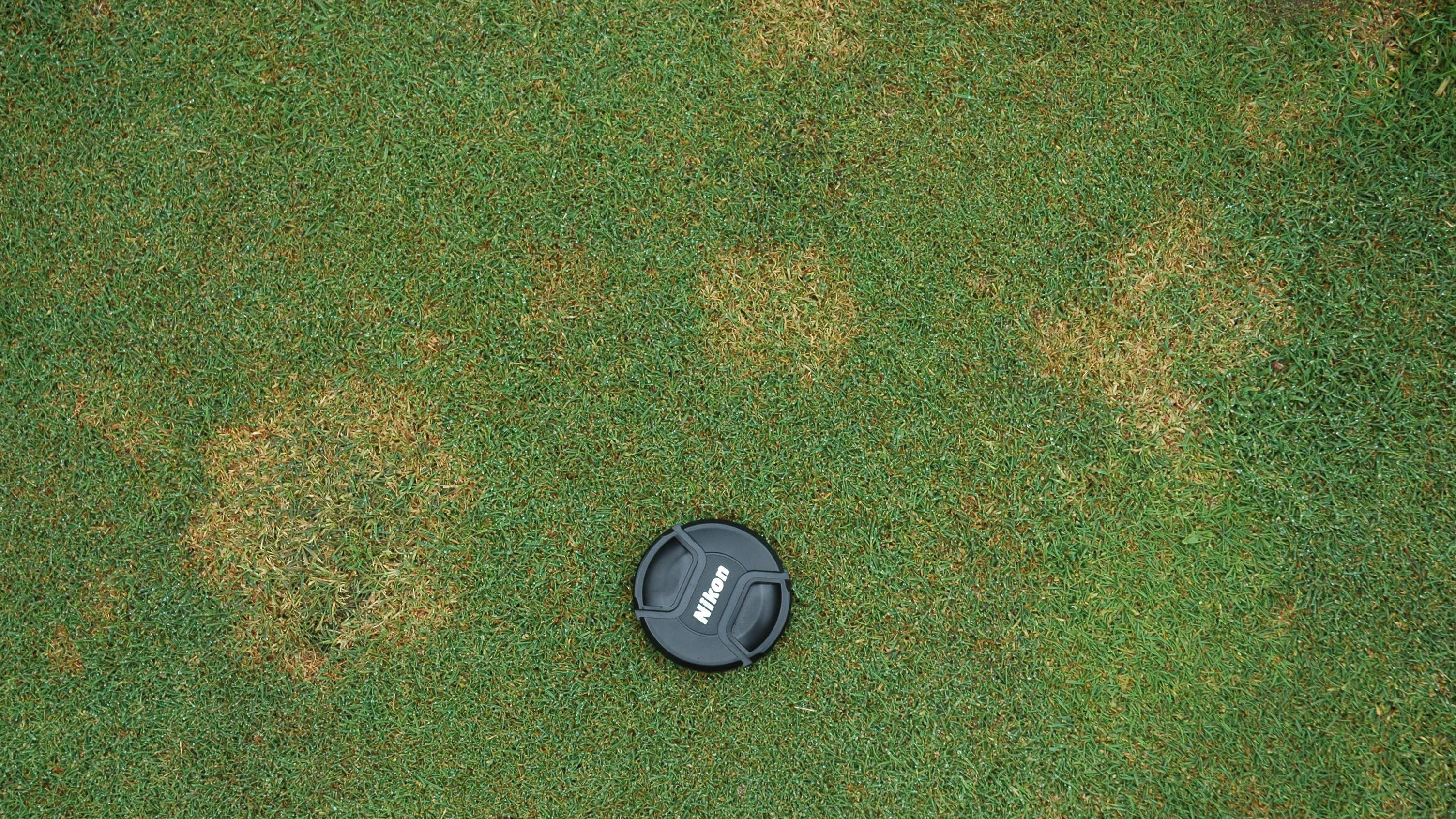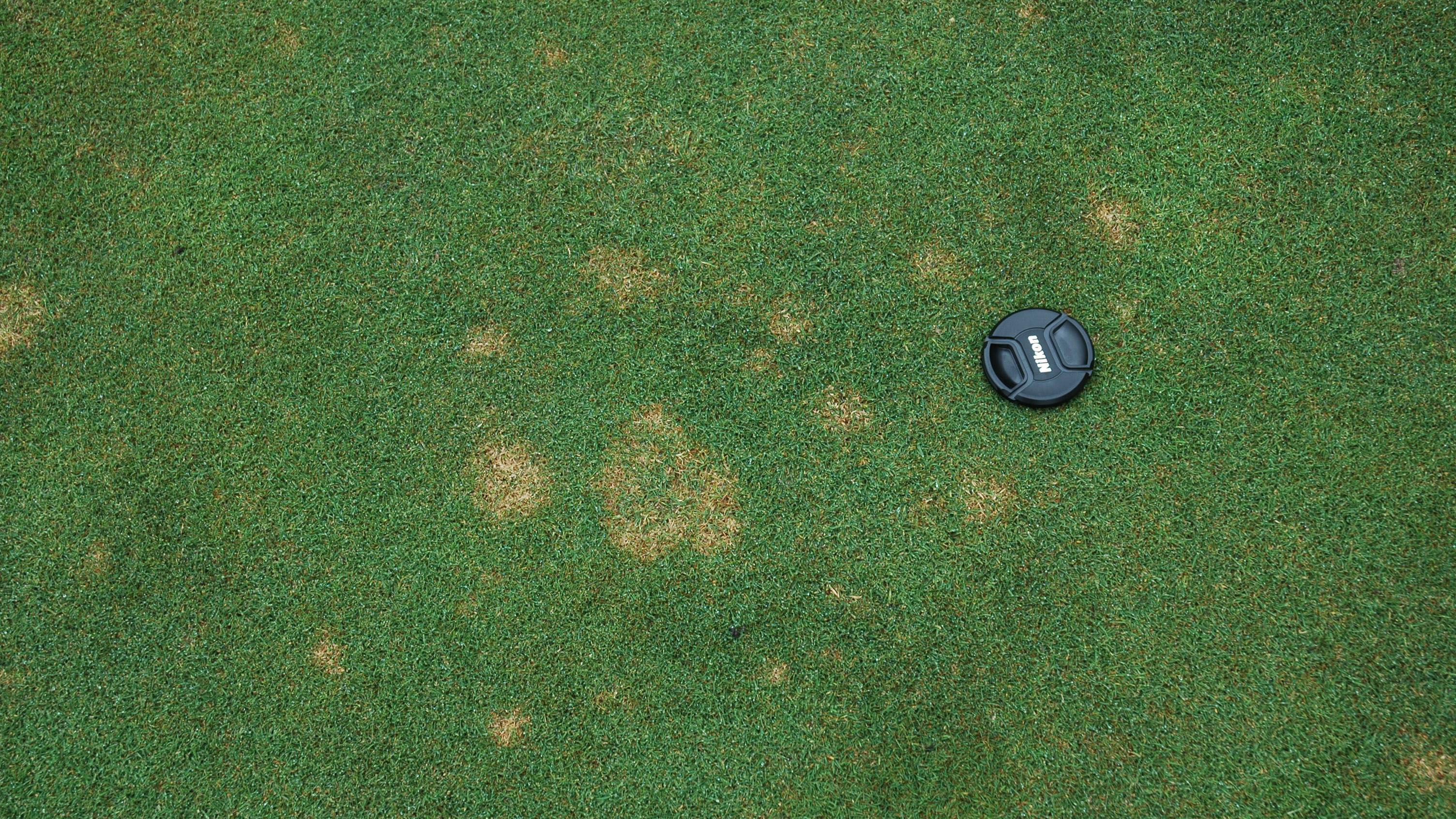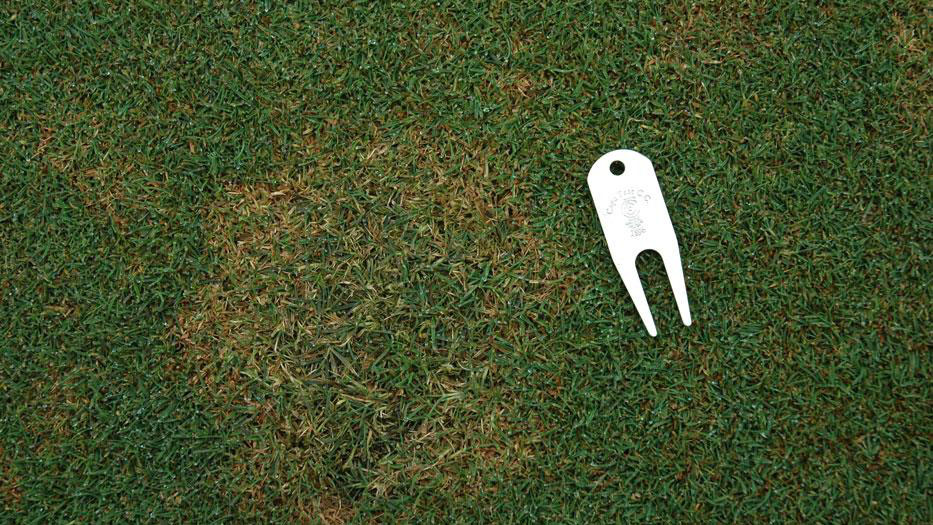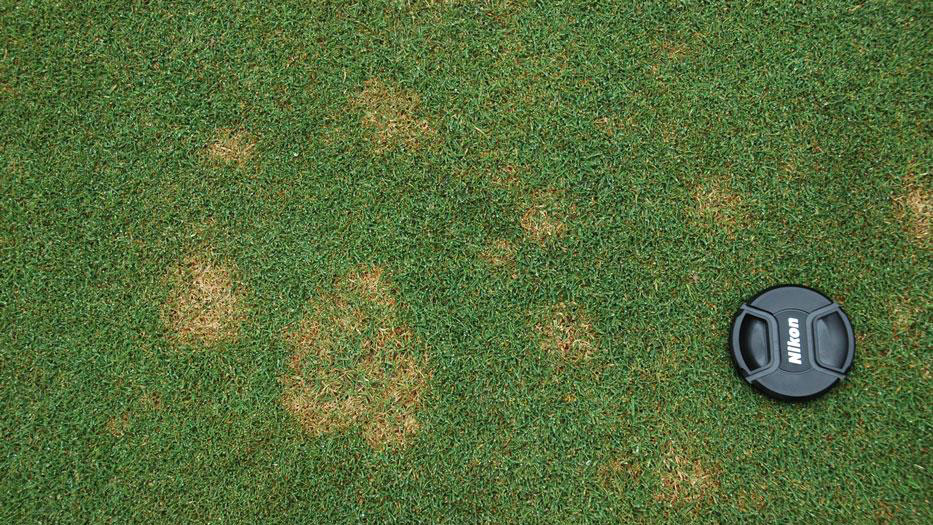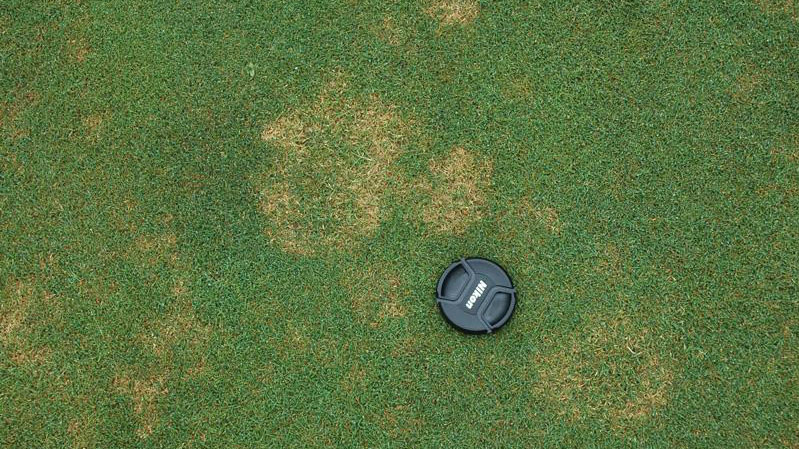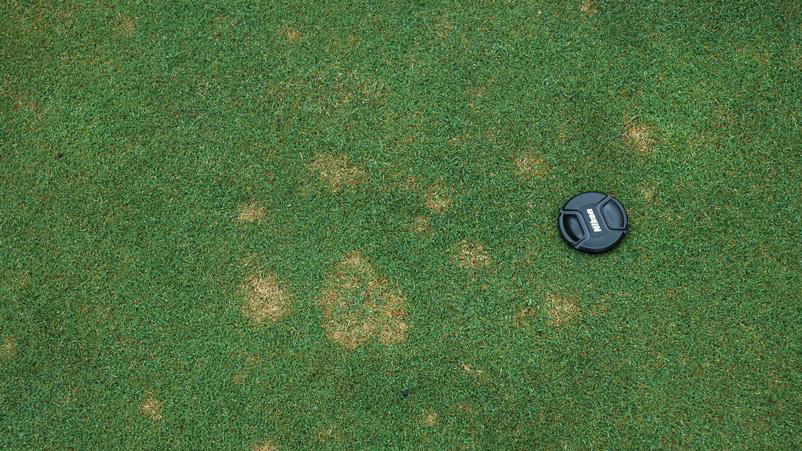Symptoms
Pink snow mold develops during periods of snow cover, with symptoms of the disease becoming evident as the snow melts. The disease appears in roughly circular patches from 2 inches to 1 foot in diameter that are white or light tan in color. A ring of salmon or pink-colored growth is present on the outer edge of patches when the disease is actively developing. The infected leaves within the patches are usually collapsed and matted down upon themselves.
Development Factors
Disease activity is most severe when snow falls on unfrozen ground; however, activity can occur without snow cover during cool (less than 60°F) wet weather. Excessive foliar growth and thatch buildup are the most important factors encouraging development of pink snow mold and Microdochium patch. Restricted air movement, poor soil drainage, inadequate levels of potassium, and heavy traffic can also enhance the disease. The disease may also develop under tree leaves that remain on the turf for long periods during cold, wet weather.
Cultural Control
Do not apply nitrogen when cold weather is expected or before the first expected prolonged snow cover. Continue mowing in the fall until foliar growth stops completely. These steps will prevent a buildup of lush foliage that is highly prone to pink snow mold or Microdochium patch.
Improve surface drainage, control traffic patterns, reduce thatch accumulations, and aerify regularly in areas that have been severely affected by the disease in the past. Prune trees and remove unwanted vegetation that impedes air movement. Frequently remove leaves and other debris during autumn and winter from turf that is not covered with snow.
In regions where heavy snow is anticipated, take steps to minimize the duration of snow cover. Erect snow fences or plant landscape plants in strategic locations to prevent excess snow accumulation. Prevent traffic on snow-covered turf, as compacted snow will melt more slowly and increase damage from pink snow mold.
Chemical Control
Fungicides are effective for control of Microdochium patch (aka pink snow mold). In the case of pink snow mold, apply fungicides before snow cover to prevent disease development. Mapping and spot-treatment of areas where pink snow mold is most severe can significantly reduce fungicide expenditures. In regions where prolonged snow cover does not occur, apply fungicides when symptoms of Microdochium patch are first observed.
* Products marked with an asterisk are not labeled for home lawn use.
| Fungicide and Formulation1 | Amount of Formulation2 | Application Interval (Days)3 | Efficacy Rating | Resistance Risk | FRAC Code4 |
| azoxystrobin (Heritage) WG TL G |
0.4 2 4 lbs |
10 to 28 10 to 28 10 to 28 |
++ |
Medium | 11 |
| azoxystrobin + acibenzolar-S-methyl (Heritage Action)* | 0.4 | refer to label | ++ | Medium | 11/P01 |
| azoxystrobin + chlorothalonil (Renown)* | 2.5 to 4.5 | 14 to 21 | ++ | Low | 11/M5 |
| azoxystrobin + difenoconazole (Briskway)* | 0.5 to 1.2 | 14 to 28 | ++ | Medium | 11/3 |
|
azoxystrobin + propiconazole (Headway) EC |
|
|
+++ | Medium | 11/3 |
| azoxystrobin + propiconazole (Compendium) | 1.3 to 2.6 | 14 to 28 | +++ | Medium | 11/3 |
| azoxystrobin + tebuconazole (Strobe T)* | 0.75 to 1.5 2.4 |
14 to 21 1 application |
++++ | Medium | 11/3 |
|
benzovindiflupyr + difenoconazole (Ascernity)* |
1.0 | 21 to 28 | ? | Medium | 7/3 |
| chlorothalonil + acibenzolar-S-methyl (Daconil Action)* | 5.4 | 21 to 28 | ++ | Low | M5/P01 |
| chlorothalonil + fluoxastrobin (Fame C)* | 3 to 5.9 | 28 | ++ | Medium | M5/11 |
| chlorothalonil + iprodione + thiophanate-methyl + tebuconazole (Enclave)* | 7 to 8 | 28 | ++++ | Low | M5/2/1/3 |
| chlorothalonil + propiconazole (Concert II)* | 8.3 | 14 to 28 | ++++ | Low | M5/3 |
| chlorothalonil + propiconazole + fludioxonil (Instrata)* | 5 to 11 | late fall | ++++ | Low | M5/3/12 |
| chlorothalonil + thiophanate-methyl (Spectro)* | 3.72 to 5.76 | 7 to 14 | +++ | Medium | M5/1 |
| fluazinam (Secure)* | 0.5 | late fall | +++ | Low | 29 |
| fluazinam + acibenzolar-S-methyl (Secure Action)* | 0.5 | late fall | +++ | Low | 29/P01 |
| fluazinam + tebuconazole (Traction)* | 1.3 | late fall | ++++ | Low | 29/3 |
| fludioxonil (Medallion) | 1 to 2 | 7 to 14 | +++ | Low | 12 |
| fluopyram + trifloxystrobin (Exteris Stressgard) | 4.1 to 6 | 10 to 14 | +++ | Medium | 7/11 |
| fluoxastrobin (Fame) SC G |
0.2 to 0.4 2.3 to 4.6 lbs |
14 to 28 14 to 28 |
+ | Medium | 11 |
| fluoxastrobin + tebuconazole (Fame T)* | 0.45 to 0.9 | 21 to 28 | ++++ | Medium | 11/3 |
| fluxapyroxad (Xzemplar) | 0.26 | 14 to 28 | ++ | Medium | 7 |
| flutolanil + thiophanate-methyl (SysStar) | 4 to 6.12 | 1 application | +++ | Medium | 7/1 |
| iprodione (26GT)* | 4 to 8 | 1 to 2 applications | +++ | Medium | 2 |
| iprodione + thiophanate-methyl (26/36)* | 1 to 4 4 to 8 |
14 to 21 1 application |
++++ | Medium | 2/1 |
| iprodione + trifloxystrobin (Interface)* | 4 to 7 | 14 to 21 | ++++ | Medium | 2/11 |
| isofetamid + tebuconazole (Tekken)* | 3 oz | 14 to 28 | ++++ | Medium | 7/3 |
| mancozeb (Fore)* (Dithane)* |
6 to 8 6 to 8 |
14 to 42 14 to 42 |
+ | Low | M3 |
| mefentrifluconazole + pyraclostrobin (Navicon)* | 0.7 to 0.85 | 14 to 28 | +++ | Medium | 3/11 |
| metconazole (Tourney) | 0.37 to 0.44 | late fall | +++ | Medium | 3 |
| mineral oil (Civitas) + proprietary pigment (Civitas Harmonizer)* | (8 to 32) + (1 to 4) | 7 to 21 | +++ | Low | -- |
| myclobutanil (Eagle) | 1.2 to 2.4 | prior to snow cover | ++ | Medium | 3 |
| propiconazole (Banner MAXX II) | 2 to 4 | fall to early spring | ++++ | Medium | 3 |
|
prothioconazole (Densicor)* |
0.196 | 14 to 21 | ++++ | Medium | 3 |
| pydiflumetofen (Posterity)* | 0.08 to 0.16 | 14 to 28 | ? | Medium | 7 |
|
pydiflumetofen + azoxystrobin + propiconazole (Posterity XT)* |
1.5 to 3 | 14 to 28 | ++++ | Medium | 7/11/3 |
| pyraclostrobin (Insignia) WG SC |
0.5 to 0.9 0.7 |
14 to 28 14 to 28 |
+++ | Medium | 11 |
| pyraclostrobin + boscalid (Honor)* | 0.55 to 1.1 | 14 to 28 | +++ | Medium | 11/7 |
| pyraclostrobin + fluxapyroxad (Lexicon Intrinsic) | 0.47 | 14 to 28 | +++ | Medium | 11/7 |
| pyraclostrobin + triticonazole (Pillar G) | 3 lbs | 28 | + | Medium | 11/3 |
| tebuconazole (Torque)* (Mirage Stressgard)* |
0.6 to 1.1 1 to 2 |
prior to snowfall 10 to 28 |
+++ | Medium | 3 |
| thiophanate-methyl (3336) (3336 Plus) (3336 G) |
2 to 4 2 to 4 1.5 to 6 lbs |
14 14 to 28 14 |
+++ | Medium | 1 |
| trifloxystrobin (Compass) | 0.2 to 0.25 | fall to early spring | +++ | Medium | 11 |
| trifloxystrobin + triadimefon (Armada) (Tartan)* |
1.2 to 1.5 2 |
fall to early spring fall to early spring |
+++ | Medium | 11/3 |
| triticonazole (Trinity) (Triton Flo) |
1 to 2 0.28 to 1.1 |
10 to 14 10 to 14 |
+++ | Medium | 3 |
| 1 Other trade names with the same active ingredients are labeled for use on turfgrasses and can be used according to label directions. 2 Units are oz, fl oz, or lb depending on formulation. Apply fungicides in 2 to 5 gallons of water per 1,000 square feet according to label directions. Use lower rates for preventive and higher rates for curative applications. 3 Use shorter intervals when conditions are very favorable for disease. 4 Fungicide Resistance Action Committee code. Products with same code have the same mode of action and are in the same chemical class. * Products marked with an asterisk are not labeled for home lawn use. |
|||||
| Efficacy Rating ++++ = excellent control when conditions are highly favorable for disease development +++ = good control when disease pressure is high, excellent control when disease pressure is moderate ++ = good control when disease pressure is moderate, excellent control when disease pressure is low + = good control when disease pressure is low ? = not rated due to insufficient data |
|||||
| Resistance Risk Low = Rotate to different chemical class after 3-4 applications; tank mixing not necessary Medium = Rotate to different chemical class after 1-2 applications; tank-mixing with low or medium risk product recommended High = Rotate to different chemical class after EVERY application; tank-mix with low or medium risk product for EVERY application ? = not rated due to insufficient data |
|||||
Species Data
- HOST SPECIES
- bentgrass, bermudagrass, bluegrasses
- MONTHS WITH SYMPTOMS
- November to March
- STAND SYMPTOMS
- FOLIAR SYMPTOMS LOCATION / SHAPE
- blighting of entire leaves
- FOLIAR SYMPTOMS COLOR
- pink, white, tan
- ROOT / CROWN SYMPTOMS
- none
- FUNGAL SIGNS
- mycelium, jelly-like spore-masses
Publication date: Nov. 15, 2017
Reviewed/Revised: Dec. 16, 2019
Recommendations for the use of agricultural chemicals are included in this publication as a convenience to the reader. The use of brand names and any mention or listing of commercial products or services in this publication does not imply endorsement by NC State University or N.C. A&T State University nor discrimination against similar products or services not mentioned. Individuals who use agricultural chemicals are responsible for ensuring that the intended use complies with current regulations and conforms to the product label. Be sure to obtain current information about usage regulations and examine a current product label before applying any chemical. For assistance, contact your local N.C. Cooperative Extension county center.
N.C. Cooperative Extension prohibits discrimination and harassment regardless of age, color, disability, family and marital status, gender identity, national origin, political beliefs, race, religion, sex (including pregnancy), sexual orientation and veteran status.

